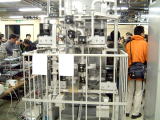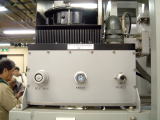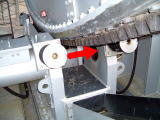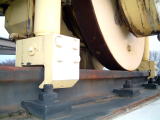 |
||||||||||||||||||
 |
||||||||||||||||||
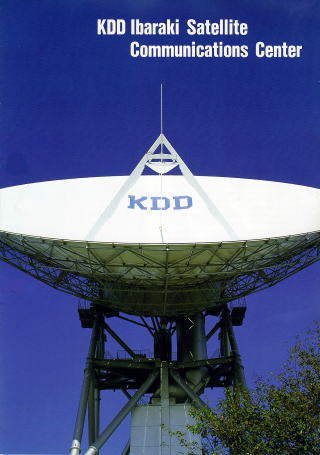 |
1963年11月23日午前5時27分にリレー1号衛星を用いたアメリカからの公開テレビ伝送実験がKDD茨城宇宙通信実験所で行われた。同日午前8時58分「ケネディ大統領暗殺」を伝える衝撃的なニュースを受信することになり、日本の国際衛星通信は劇的な幕開けとなった。 近年の光ファイバーネットワーク網の充実など通信環境変化にともない、KDDIは衛星通信の運用体制を縮小し、業務を山口県山口市のKDDI山口衛星通信センターに集約中 住所 茨城県高萩市石滝字呉坪650 KDDI株式会社茨城衛星通信センター |
|||||||||||||||||
| 第4施設 | ||||||||||||||||||
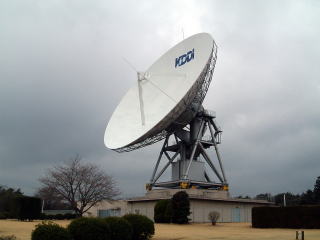 |
|
|||||||||||||||||
|
4G帯 LNA(低雑音増幅器 半導体冷却)アンテナで収束た電波はLNAで増幅される |
|||||||||||||||||
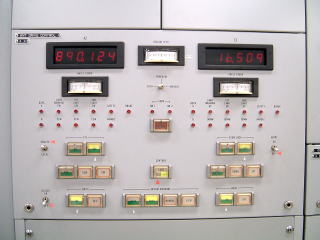 |
第4施設のローカルACU、EL(仰角)の角度表示0.001度単位、AZ(水平)角度表示はデコーダIC故障のようで表示異常(EME運用中で月を追尾中) |
|||||||||||||||||
| 第5施設 | ||||||||||||||||||
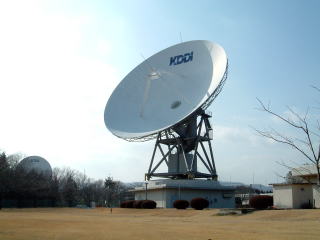 |
|
|||||||||||||||||
|
強風時には、アンテナの破損を防止するためパラボラアンテナを天頂に向けロックする(天頂ロックという歌舞伎ロックではない)左側の写真は、アンテナが天頂に向くとギヤの部分が固定用の穴の開いた板になり左からシリンダーを突出し固定する(閂). 右側の写真は強風時にレールを掴んでアンテナの転倒するのを防止する。運用時は衛星を補足するためレール上を移動する。可動部分の重量は380トン |
|||||||||||||||||
| マルチビーム地球局 | ||||||||||||||||||
 |
|
|||||||||||||||||
| Nobeyama Radio Observatory (NRO) | ||||||||||||||||||
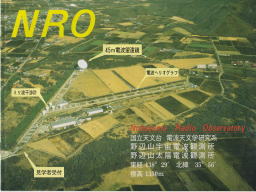 |
The Nobeyama Radio Observatory (NRO) is a division of the National Astronomical Observatory of Japan (NAOJ) under the National Institutes of Natural Sciences (NINS). NRO operates powerful, advanced radio telescopes such as the 45 m radio telescope, the Nobeyama Millimeter Array (NMA), and the Nobeyama Radioheliograph. A large number of scientists from around the world visit NRO to use these telescopes for researches in astronomy and astrophysics. Maintenance, upgrades, and new technical innovations are ceaselessly made all year round. | |||||||||||||||||
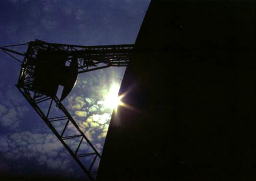 Photo by kanzaki |
One of the world's largest radio telescopes operating in short millimeter wavelength. Scientific outcomes from this instrument include discovery of a supermassive black hole and a number of interstellar molecules, and cover wide range of research fields such as formation of stars and planetary systems, structure and activity of galaxies, and interstellar chemistry. |
|||||||||||||||||
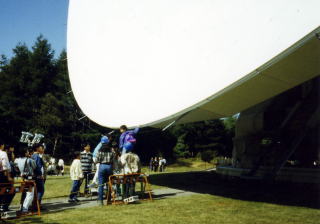 Photo by kanzaki |
There is an event touched to a parabolic antenna in an open day. | |||||||||||||||||
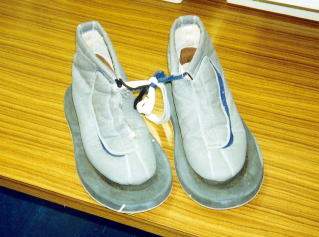 Photo by kanzaki |
These shoes are for walking a precise surface of an
antenna. The name is "ninja shoes". |
|||||||||||||||||
| Usuda Deep Space Center | ||||||||||||||||||
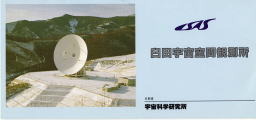 |
Japan Aerospace Exploration Agency Usuda Deep Space Center |
|||||||||||||||||
 Photo by kanzaki |
A towering 64-meter radio telescope. | |||||||||||||||||
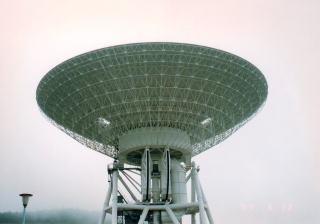 Photo by kanzaki |
The Usuda Deep Space Center was established in Usui, Nagano Prefecture, in 1984, as an affiliated facility of the former Institute of Space and Astronautical Science (ISAS). |
|||||||||||||||||
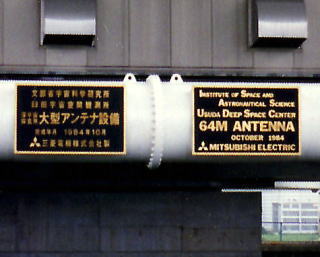 Photo by kanzaki |
The Center conducts command operations and receives data from deep space probes which observe planets and comets | |||||||||||||||||
Photo by kanzaki |
The remote location of the Center was chosen carefully to reduce noise from towns, allowing for the reception of faint and subtle signals from space. | |||||||||||||||||
Photo by kanzaki |
The main facility is a large parabolic antenna (64m-dia., 1980t.). X-band communications (8 GHz) are used for with deep space probes, while S-band (2 GHz) and X-band (for receiving only) are used for other probes. In addition to the Center, only NASA (U.S.A.), ESA (Europe), and IKI (Russia) own parabolic mirrors of this size. |
|||||||||||||||||
 |
At the dawn of space aeronautics in the 20th century, three organizations were established in Japan: The Institute of Space and Astronautical Science (ISAS), which was devoted to space and planetary research; the National Aerospace Laboratory of Japan (NAL), which focused on research and development of next-generation aviation; and the National Space Development Agency of Japan (NASDA), which was responsible for development of large-size launch vehicles, as represented by H-IIA, satellites, and the International Space Station. | |||||||||||||||||
| Katsuura Tracking and Communication Station | ||||||||||||||||||
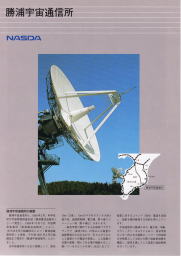 |
Katsuura Tracking and Communication Station was established in Katsuura, Chiba, in February, 1968 as Katsuura radiowave tracking base of the Science and Technology Agency (STA) Space Development Headquarter, and was affiliated with the National Space Development Agency in October, 1969. | |||||||||||||||||
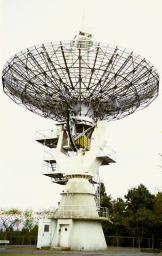 Photo by kanzaki |
The main role of this Station is to track and control satellites. After receiving telemetry from satellites, it checks their location, altitude, and instrument functions. It also sends commands to satellites as required, in order to maintain and control them. Besides four parabolic antennas, two 18m, one 13m, and one 10m, there are also tracking and control building, electric building, and Nonozuka collimation building. Visitors can control one of the 18m antennas. |
|||||||||||||||||
| Arecibo Observatory, cylindrical reflector type | cylindrical reflector ≠ parabolic reflector | |||||||||||||||||
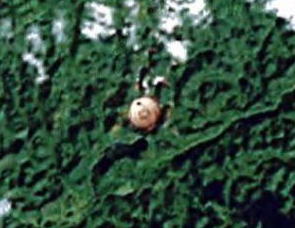 |
Arecibo / Puer to Rico. It is known for the nearby world-famous Arecibo Observatory, which boasts the largest single telescope ever constructed. While the
observatory exists to support scientific studies, a number of Hollywood movies have been filmed there, most
recently GoldenEye and
Contact. The Arecibo telescope is distinguished by its enormous size; the main collecting dish is 305 m in diameter, constructed inside the depression left by a karst sinkhole. The dish is the largest curved focusing dish on Earth, giving Arecibo the largest electromagnetic-wave gathering capacity. The Arecibo telescope's dish surface is made of 38,778 perforated aluminium panels, each measuring about 1 m by 2 m (3 ft by 6 ft), supported by a mesh of steel cables. |
|||||||||||||||||
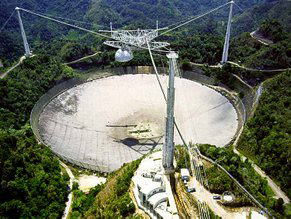 |
|
|||||||||||||||||
| Metal spinning | へら絞り | |||||||||||||||||
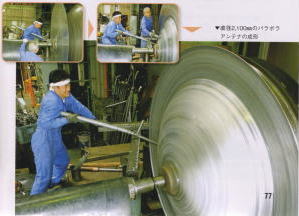 2.1m パラボラアンテナ製作中 東京 大田区 東京書籍 中学校技術・家庭科用教科書より |
スピニング加工の特長 長所 ・プレス成形と比べ複雑な形状の製品が成形可能 ・金型がオス型1つで済む、リードタイム短く金型費用も安価 ・金型を再切削して、寸法を小さくすることは容易である ・加工力が小さいため設備がコンパクト ・切削加工などと比べ材料が節減できる ・加工精度が高く,製品の表面性状も良好 ・試作品および少量多品種,短納期の品に適した工法である 短所 板厚の減少、バラツキが生じること (絞りの深さ、角R、材質の硬さによって異なる) 株式会社 北嶋絞製作所 大田区企業チャンネル |
|||||||||||||||||
| スピニング加工(へら絞り加工)とは,回転する成形型(マンドレル)に板状や管状の丸切りした金属素材(ブランク)を加工ローラやへらで押し付けて成形する塑性(そせい)加工の一手法である.金属を材料とするシェル状の製品の成形加工法として,家庭用容器,装飾工芸品,照明器具,パラボラアンテナ,ボイラ,タンク,ロケット・航空機のノズル,エンジン部品などの部品・製品の製造に広く用いられている.この加工法は熟練作業者による高度なものづくりの技能としても近年注目され,例えばH2ロケットの先端カバーなどがこうした手作業(へら絞り)によって製作されたことが広く知られている. |
|
|||||||||||||||||
